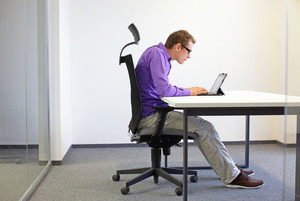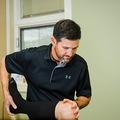
How a Forward Head Posture Effects Your Muscles
When we develop a slouched posture, it places tremendous strain on our body. Specifically, forward head posture increases the workload for many of the muscles attached to the cervical spine, which has the job of holding up the head. This is typically combined with a rounded upper back, which is known as hyperkyphosis. Over time, this upper body slouched posture can lead to muscle imbalances as our body attempts to adapt and find efficient ways to maintain our eyes looking straight ahead. Over time some of our muscles become weakened, whereas other muscles become shorter and tighter.
Tight Muscles Due to Poor Posture
Muscles that become short and tight due to long-term slouched posture include the suboccipital muscles, levator scapulae and upper trapezius muscles, and the muscles of the chest.
The suboccipitals are a triangular group of muscles that connect between the back of our skull and the top of our cervical spine. They help rotate and extend the head. As our head sits forward, these are working hard when we continue to look straight ahead.
The levator scapula and upper trapezius assist in raising our shoulder blades. As we slouch forward our shoulder blades will rise causing a shortening of both these muscles. For this reason, this is an extremely common area to find muscle knots and trigger points.
The pectoralis major and pectoralis minor muscles make up our chest muscles. The muscles become shortened as our shoulders round forward with a slouched posture.
Weak Muscles Due to Poor Posture
Common muscles that weaken due to long-term forward head posture include our deep neck flexors along with muscles that retract and depress our shoulder blades.
The job of the deep neck flexors is to help stabilize the neck. As our chin begins to poke forward, as is the case with slouched posture, are utilized less and less resulting in weakness.
The middle and lower trapezius, and rhomboid muscles act to move our shoulder blades back and down. With a slouched posture our shoulder blades to move forward and up causing these muscles to weaken over time.
Over time, poor posture can lead to:
- Neck Pain
- Headaches
- Nerve issues in the arms and hands (pins and needles, numbness)
- Headache
- Jaw Pain
- Reduced respiratory function and efficiency
The human body was simply not built to maintain one position for and extended period. Taking breaks, stretching, and simply moving every 30 minutes should be an essential part of your daily routine if you work at a desk or sit for extended periods of time.
If you’re experiencing headaches, neck pair, or other symptoms related to prolonged poor posture, contact us today!
Check out this video as we demonstrate a common postural exercise, we often recommend to many of our patients.




